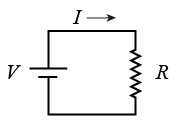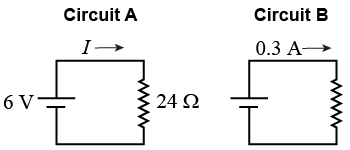|
Ohm’s law states that the current I through a conductor is the voltage drop V divided by resistance R (or, in other words, I = V/R). The SI unit for resistance is the ohm, abbreviated Ω. Conductors are materials that offer little resistance to current flow when subjected to a voltage. Insulators are materials that strongly resist current flow. Resistors are used in electric circuits to control current flow. Engineers design the resistance of electrical devices to draw the right current when connected to the right voltage. 
|
|
Ohm’s law, ohm (Ω), resistance, resistor, digital multimeter, electrical conductor, electrical insulator
|
|
|
|
Review problems and questions |
|

- A resistor and voltage source are connected in a simple closed circuit, as shown here. The resistor obeys Ohm’s law.
- If the voltage V doubles but resistance stays the same, what happens to the current I?
- If the resistance R doubles but the voltage remains unchanged, what happens to the current?

 |
Answer: - The current doubles.
- The current is halved.
Solution: - The current doubles. Ohm’s law states that current equals voltage divided by resistance (I = V/R). If you double a fraction’s numerator while leaving the denominator unchanged, you double the value of the fraction. Since V is the numerator in this instance, doubling the voltage drop will double the current. In other words, I is directly proportional to V.
- The current is halved. Ohm’s law states that current equals voltage divided by resistance (I = V/R). If you double a fraction's denominator while leaving the numerator unchanged, you halve the value of the fraction. Since R is the denominator in this instance, doubling the resistance will halve the current. In other words, I is inversely proportional to R.

|

- Two simple closed circuits are shown. Which carries a larger amount of current?
- A carries a larger current than B.
- A carries a smaller current than B.
- A and B carry equal amounts of current.
- You cannot tell without more information.

 |
The correct answer is ii, since Circuit B carries more current than Circuit A. There is enough information to answer the question, since we are asked to compare only one quantity, namely current. The current flowing through Circuit B has been stated. The current flowing through Circuit A has not been stated, but we have been given the two other quantities that appear in Ohm's law. That allows us to solve for the unknown current: The current flowing through Circuit A is 0.25 A, which is less than the 0.3 A flowing through Circuit B. 
|
- Which of these is the correct equivalent to an ohm (Ω) ?
- V/A
- A/V
- V A
- V A2
- A2/V

 |
Choice a is correct; an ohm is a volt per amper, or V/A. This is apparent from rearranging Ohm’s law to R = V/I. 
|
- A child coats the “top” (+ end) of a flashlight battery with thick shiny paint. He allows the paint to dry. He then inserts the battery into his flashlight and slides the switch to the “on” position. The bulb immediately gives off light. What can we conclude about the paint?
- The paint is an insulator.
- The paint contains free (mobile) electrons.
- The paint contains flakes of copper.

 |
The answer is b, the paint contains free (mobile electrons). The paint must be a conductor, since the circuit was closed when the switch was turned to the “on” position—and the current had to pass through the paint to flow out of the battery. This eliminates choice a, since a conductor is the opposite of an insulator. Choice b must be true, because the circuit could not conduct current unless the paint had some free (mobile) electrons. Choice c might be true, since copper is a good conductor—but it does not have to be true, since many other materials also conduct electricity. Hence b is the best answer. 
|
Take a Quiz |

